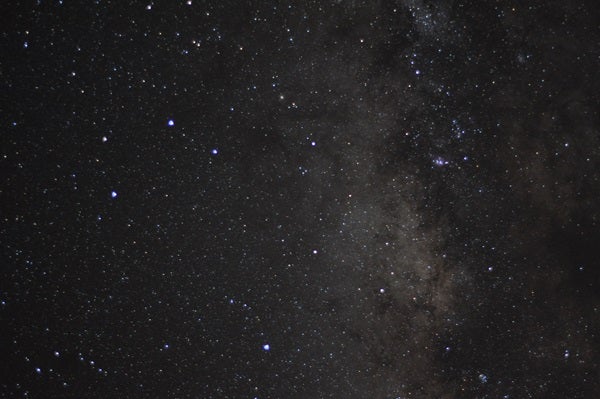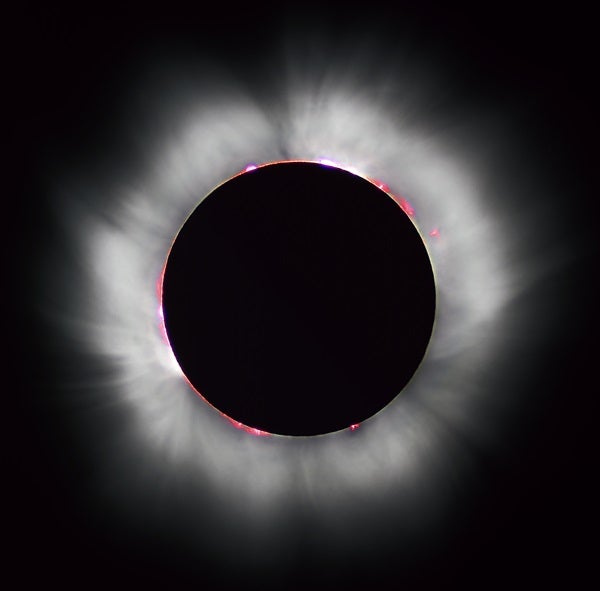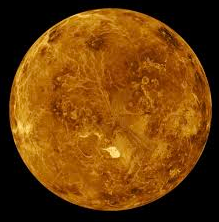Friday, August 18
Evenings this week are great times to explore the constellation Sagittarius the Archer. This star group lies due south and at peak altitude around 10 p.m. local daylight time, shortly after the last vestiges of twilight have faded away. The brightest stars within the constellation form the shape of a teapot — a distinctive asterism once you’ve found it. The central regions of the Milky Way pass through Sagittarius, so it’s always worth exploring the area through binoculars or a telescope.
The Moon reaches perigee, the closest point in its orbit around Earth, at 9:18 a.m. EDT. It then lies 227,497 miles (366,121 kilometers) from Earth’s center.
Saturday, August 19
By the time morning twilight starts to paint the sky, your eyes will be drawn to the eastern sky for a meeting of the night sky’s two brightest objects. Brilliant Venus rises first, clearing the horizon shortly before 3:30 a.m. local daylight time. Less than a half-hour later, the waning crescent Moon joins the planet. The two make a stunning pair as they climb higher in the twilight sky. Venus, which shines at magnitude –3.9, appears 20° above the horizon an hour before sunrise.
Sunday, August 20
Comet PANSTARRS (C/2015 ER61) currently hovers around 10th or 11th magnitude, bright enough to see through most small telescopes. But its main claim to fame early this week is its convenient location just south of the Pleiades star cluster (M45). From August 14 to 21, the solar system object appears as a fuzzy patch of light passing less than 1° south of the dipper-shaped cluster.
Monday, August 21
The day amateur astronomers have been looking forward to for decades is finally upon us. For the first time since 1979, the Moon’s dark umbral shadow touches the continental United States, bringing a total solar eclipse. People in the path of totality, which stretches from the Oregon coast to the shores of South Carolina, will see the Sun’s bright surface disappear and its ethereal corona blossom around the Moon’s pitch-black disk. For complete details on observing this historic event, see the August issue of Astronomy.
Tuesday, August 22
Distant Neptune reaches opposition and peak visibility in two weeks, but the view now is essentially the same. The ice giant planet rises during evening twilight and climbs nearly halfway to the zenith in the southern sky by 2 a.m. local daylight time. The magnitude 7.8 planet lies in Aquarius, 1.5° east of 4th-magnitude Lambda (l) Aquarii. You’ll need binoculars to spy Neptune and a telescope to see its blue-gray disk, which spans 2.4″.
Wednesday, August 23
Although Saturn reached opposition more than two months ago, it remains a tempting target in the evening sky. The ringed world stands highest in the south an hour after sunset and doesn’t dip below the horizon until after midnight local daylight time. Saturn shines at magnitude 0.4 against the backdrop of southern Ophiuchus, a constellation whose brightest star glows six times fainter than the planet. When viewed through a telescope, Saturn’s globe measures 17″ across while its spectacular ring system spans 39″ and tilts 27° to our line of sight.
Thursday, August 24
Uranus’ visibility continues to improve week by week. It now appears nearly 25° high in the east by midnight local daylight time and climbs highest in the south as morning twilight commences. The magnitude 5.7 planet lies in Pisces, 1.1° north of magnitude 4.3 Omicron (o) Piscium. A telescope reveals Uranus’ blue-green disk, which spans 3.6″.
Friday, August 25
Following its meeting with the Sun earlier this week, the Moon has now climbed into view in the evening sky. Be sure to catch the 20-percent-lit crescent this evening, when it forms a pretty triangle with magnitude –1.8 Jupiter and 1st-magnitude Spica. All three objects lie in the constellation Virgo and stand well clear of the west-southwestern horizon during evening twilight. And don’t pass up an opportunity to view Jupiter through a telescope. The giant planet’s disk spans 33″ and shows a wealth of atmospheric detail.
Saturday, August 26
Venus appeared among the background stars of Gemini the Twins yesterday morning, but you’ll find it against the backdrop of Cancer the Crab today. This border crossing sets up a pretty conjunction a week from now, when the gleaming planet appears 1° south of the Beehive star cluster (M44).
Mercury reaches inferior conjunction, passing between the Sun and Earth, at 5 p.m. EDT. The innermost planet will return to view before dawn in early September.
Sunday, August 27
The constellations Ursa Major the Great Bear and Cassiopeia the Queen lie on opposite sides of the North Celestial Pole, so they appear to pivot around the North Star (Polaris) throughout the course of the night and the year. In late August and early September, these two constellations appear equally high as darkness falls. You can find Ursa Major and its prominent asterism, the Big Dipper, about 30° above the northwestern horizon. Cassiopeia’s familiar W-shape, which currently lies on its side, appears the same height above the northeastern horizon. As the night progresses, Cassiopeia climbs above Polaris while the Big Dipper swings below.












